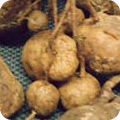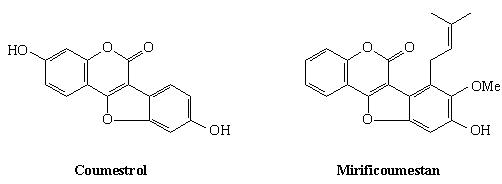Pueraria Mirifica Clinical Studies
 Source :
Medical Plant Research Institute Department of Medical Sciences,
Ministry of Public Health, Thailand. The plants are commonly found in abundance
in forests in the North, the West and the North East of Thailand. Active
principles in this plant are found in the inter-connected tuberous roots, which
look like chains of round-shaped bulbs. The shape and size of the tuberous roots
are diverse and depend on the environment in which they exists. Source :
Medical Plant Research Institute Department of Medical Sciences,
Ministry of Public Health, Thailand. The plants are commonly found in abundance
in forests in the North, the West and the North East of Thailand. Active
principles in this plant are found in the inter-connected tuberous roots, which
look like chains of round-shaped bulbs. The shape and size of the tuberous roots
are diverse and depend on the environment in which they exists.
There are nine species of plants in the genus Pueraria in Thailand that look
alike, However, the authenticity of Pueraria Mirifica can be clearly verified
from the distinct characteristics of the stamen of the flower and its hairy pod.
 The tuber enable to enlarge and accumulate at least 13 known natural
chemicals classified as PHYTOESTROGENS comprising: miroestrol, daidzein,
genistin, genistein, B-sitosterol, stigmasterol, coumestrol, pueraria,
compesterol, mirificoumestan, kwakhurin and mirificin. The tuber enable to enlarge and accumulate at least 13 known natural
chemicals classified as PHYTOESTROGENS comprising: miroestrol, daidzein,
genistin, genistein, B-sitosterol, stigmasterol, coumestrol, pueraria,
compesterol, mirificoumestan, kwakhurin and mirificin.
In the East, the belief in the miraculous rejuvenating properties of Pueraria
Mirifica has been passed down from one generation to another for centuries.
The rhizome extract of Pueraria mirifica contains "
phytoestrogens " (Hormone from Plant) comprising isoflavones (daidzin, daidzein,
genistin, genistein and puerarin) and others such as miroestrol and its
derivatives, beta-sitosterol, stigmasterol, coumestrol, puerarin,
mirificoumestan, kwakhurin, mirificin, b-sitosterol, alkane alcohol, fat, and
sugar.
It has been reported that Pueraria mirifica contains estrogenic
substance miroestrol, which can be found in the dry rhizome of Pueraria mirifica
about 0.002-0.003%. This substance has been proven 2 times more effective than
human estrogen.
Phytoestrogen Pueraria mirifica is also high in phytoestrogen,
substance which imitates female estrogen.

A series of studies involving breast cell lines and the activity of Pueraria
mirifica in vitro have been performed by the Emory University School of Medicine
in Atlanta, Georgia, USA, and the Department of Obstetrics and Gynecology,
Phramongkutklao College of Medicine, Bangkok, Thailand. These studies have shown
that Pueraria mirifica root extract (Smith Naturals Co Ltd., Bangkok) has potent
anti-estrogenic properties against aggressive cell cancer lines in vitro,
especially the proliferative estrogen receptor-positive (ER+) breast cancer
lines (T47-D, MCF-7, and ZR-75-1) obtained from the MD Anderson Cancer Institute
(Texas) and the National Cancer Institute (NCI) at the U.S. National Institutes
of Health (NIH). Pueraria mirifica promotes fibroblasts in normal breast cells
and inhibits estrogen-dependent breast cancer cells. Unpublished, 2001, Sawatsri,
S., Juntayanee, B., Jitpatima, S., Boonnao, P., Kampoo, C., Ayuttaya, N.,
Wongyai, S. and Sidell, N.
According to the study conducted at the School of Medicine, Saint Mariane
University, Tokyo, Japan by Kuramoshi, T. and Smitasiri, Y. about the
preliminary study of Pueraria mirifica in Japanese females, 50 healthy
menstruating volunteer females, ages 20 to 49, were given between 100 to 600 mg
orally of Pueraria mirifica root powder daily as capsules for 7 days, two weeks
after menstruation. No reports of abnormally heavy, severe, or missed
menstruation were recorded.
Animal Test: There were reports during the year 1960-61 from the British
researchers to test the effects of miroestrol; the key chemical from this herb
in the ovariectomized and the premature female rats. The results showed the
estrogenic effects of this chemical. It implied that the sythetic estrogen or
animal estrogen or even human estrogen could be substituted by this chemical.
Human Test: PM root has also been tested in human and was reported in 1961 as a
potent estrogen effect. The Thai medical doctor has tested the crude extract in
the patients in the year 1941. The result also showed the promising application
of this herb.
|



 Source :
Medical Plant Research Institute Department of Medical Sciences,
Ministry of Public Health, Thailand. The plants are commonly found in abundance
in forests in the North, the West and the North East of Thailand. Active
principles in this plant are found in the inter-connected tuberous roots, which
look like chains of round-shaped bulbs. The shape and size of the tuberous roots
are diverse and depend on the environment in which they exists.
Source :
Medical Plant Research Institute Department of Medical Sciences,
Ministry of Public Health, Thailand. The plants are commonly found in abundance
in forests in the North, the West and the North East of Thailand. Active
principles in this plant are found in the inter-connected tuberous roots, which
look like chains of round-shaped bulbs. The shape and size of the tuberous roots
are diverse and depend on the environment in which they exists. The tuber enable to enlarge and accumulate at least 13 known natural
chemicals classified as PHYTOESTROGENS comprising: miroestrol, daidzein,
genistin, genistein, B-sitosterol, stigmasterol, coumestrol, pueraria,
compesterol, mirificoumestan, kwakhurin and mirificin.
The tuber enable to enlarge and accumulate at least 13 known natural
chemicals classified as PHYTOESTROGENS comprising: miroestrol, daidzein,
genistin, genistein, B-sitosterol, stigmasterol, coumestrol, pueraria,
compesterol, mirificoumestan, kwakhurin and mirificin.
